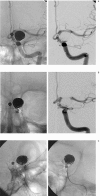Additional Rescue Stent Placement for Stabilization of a Prolapsed Coil during Stent-assisted Coil Embolization of a Wide-Neck Intracranial Aneurysm
- PMID: 20569580
- PMCID: PMC3354544
- DOI: 10.1177/159101990601200309
Additional Rescue Stent Placement for Stabilization of a Prolapsed Coil during Stent-assisted Coil Embolization of a Wide-Neck Intracranial Aneurysm
Abstract
We report a case of a 55-year-old man carrying two unruptured internal carotid artery (ICA) wide-neck aneurysms. In the same session, the smaller aneurysm was treated by coils using the remodeling technique and the large aneurysm was treated by stent-assisted coil embolization. During the stent-assisted procedure for the large aneurysm, the microcatheter tip moved from the aneurysm into the parent artery causing a prolapse of some coil loops into the vessel lumen. The distal part of the coil was tangled within the stent's struts, therefore, in order to introduce the entire coil, an attempt was made to withdraw the prolapsed loops of the coil within the microcatheter and concomitantly repositioning the microcatheter into the residual aneurysm neck through the stent struts. However this maneuver was unsuccessful. An attempt to retrieve gently the coil also failed and the coil prematurely detached. For maintaining the patency of the arterial lumen and to reduce the embolic risk, a second stent was used to pin the free coil loops. The rescue stent was positioned within the coil loops and its deployment allowed a circumferential expansion of some loops around the stent perimeter while other loops were flattened against the wall of the artery. The parent artery remained patent at one-year follow-up angiographic study. No clinical complications were observed.
Figures


Similar articles
-
Stent-assisted embolization of internal carotid artery aneurysms.J Chin Med Assoc. 2003 Aug;66(8):460-6. J Chin Med Assoc. 2003. PMID: 14604309
-
Modified balloon assisted coil embolization for the treatment of intracranial and cervical arterial aneurysms using coaxial dual lumen balloon microcatheters: initial experience.J Neurointerv Surg. 2014 Nov;6(9):704-7. doi: 10.1136/neurintsurg-2013-010936. Epub 2013 Oct 23. J Neurointerv Surg. 2014. PMID: 24153339
-
Efficacy and current limitations of intravascular stents for intracranial internal carotid, vertebral, and basilar artery aneurysms.J Neurosurg. 1999 Oct;91(4):538-46. doi: 10.3171/jns.1999.91.4.0538. J Neurosurg. 1999. PMID: 10507372
-
Stent management of coil herniation in embolization of internal carotid aneurysms.AJNR Am J Neuroradiol. 2008 Nov;29(10):1951-5. doi: 10.3174/ajnr.A1268. Epub 2008 Aug 21. AJNR Am J Neuroradiol. 2008. PMID: 18719031 Free PMC article. Clinical Trial.
-
Preliminary experience of stent salvage using Neuroform Atlas stent for procedure-related complication during coil embolization of intracranial aneurysms.Clin Neurol Neurosurg. 2020 Mar;190:105654. doi: 10.1016/j.clineuro.2019.105654. Epub 2019 Dec 28. Clin Neurol Neurosurg. 2020. PMID: 31901613
Cited by
-
Endovascular rescue treatment through stent positioning after surgical clipping of intracranial aneurysms complicated by parent artery obstruction.BMJ Case Rep. 2017 Nov 16;2017:bcr2017013321. doi: 10.1136/bcr-2017-013321. BMJ Case Rep. 2017. PMID: 29146726 Free PMC article.
-
Simultaneous stent expansion/balloon deflation technique to salvage failed balloon remodeling.BMJ Case Rep. 2015 Mar 18;2015:bcr2014011600. doi: 10.1136/bcr-2014-011600. BMJ Case Rep. 2015. PMID: 25786815 Free PMC article.
-
Risk factors for coil protrusion into the parent artery and associated thrombo-embolic events following unruptured cerebral aneurysm embolization.Interv Neuroradiol. 2015 Apr;21(2):178-83. doi: 10.1177/1591019915582375. Epub 2015 May 11. Interv Neuroradiol. 2015. PMID: 25964443 Free PMC article.
References
-
- Murayama Y, Nien YL, et al. Guglielmi detachable coil embolization of cerebral aneurysms: 11 years' experience. J Neurosurg. 2003;98:959–966. - PubMed
-
- Moret J, Cognard C, et al. The "remodelling technique" in the treatment of wide neck intracranial aneurysms: Angiographic results and clinical follow-up in 56 cases. Interventional Neuroradiology. 1997;3:21–35. - PubMed
-
- Wells-Roth D, Biondi A, et al. Endovascular procedures for treating wide-necked aneurysms. Neurosurg Focus. 2005;18:E7. - PubMed
-
- Murayama Y, Tateshima S, et al. Matrix and bioabsorbable polymeric coils accelerate healing of intracranial aneurysms: long-term experimental study. Stroke. 2003;34:2031–20377. - PubMed
LinkOut - more resources
Full Text Sources
Miscellaneous

